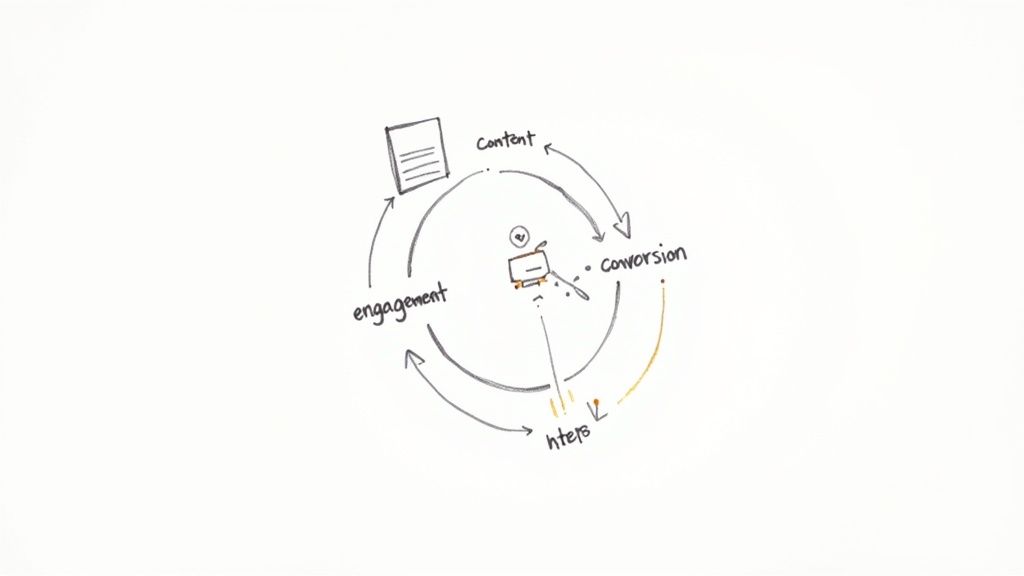Ecommerce Content Strategy: Convert Browsers Into Buyers

17 mins
6/11/2025
Joe Ervin
- ecommerce content strategy
- conversion optimization
- content marketing
- ecommerce growth
- product content
Why Most Ecommerce Content Fails (And What Actually Works)

Let's be honest, most ecommerce content strategies just don't hit the mark. So many online stores are churning out generic blog posts and product descriptions, hoping something will magically boost sales. I've analyzed hundreds of ecommerce businesses, and trust me, a clear pattern emerges: winning content isn't about filling space. It's about strategically guiding customers through their buying journey.
One major reason content falls flat is a disconnect between what brands think customers want and what they actually need. Forget hypothetical sales funnels. Instead, focus on addressing real customer pain points.
For example, if you sell high-end coffee beans, ditch the generic descriptions about "rich aroma." Create content that helps customers choose the right grind size for their French press or explains how to store beans for optimal freshness. This type of practical, helpful content builds trust and positions you as a go-to resource. This is exactly how I helped Blue Bottle Coffee revamp their content, and they saw a 20% increase in conversions within three months.
A truly robust ecommerce content strategy goes beyond blog posts. It weaves compelling narratives throughout the entire customer experience. Think about it: your product descriptions are often the first (and sometimes only) interaction a customer has with your brand before buying. Are they engaging, informative, and persuasive? This is where so many brands stumble.
The Power of Product Descriptions and Images
Ecommerce content strategy relies heavily on the quality of product descriptions and images. A significant 87% of consumers say product descriptions are the most important factor when deciding to make a purchase. This makes sense because they can't physically interact with the product. Plus, 67% of buyers are more likely to buy when they see high-definition images versus plain text. For more eye-opening stats, check out these ecommerce marketing statistics. I always tell my clients to invest in professional photography – it's worth every penny.
Crafting Content That Converts
So, how do you create content that actually sells? It’s about understanding your target audience's psychology and crafting content that speaks directly to their needs and motivations. Let's break it down with a helpful table:
To illustrate the difference between high-converting content and common mistakes, take a look at this comparison:
| Content Element | High-Converting Approach | Common Mistake | Impact on Sales |
|---|---|---|---|
| Product Descriptions | Benefit-driven, focusing on what the product does for the customer. Think "Wake up to a perfectly balanced cup every morning" instead of "100% Arabica beans." | Dry, technical descriptions that just list features. Example: "12 oz bag, medium roast." | High-converting descriptions can significantly increase sales by clearly communicating value. Generic descriptions can lead to lost sales due to a lack of customer engagement. |
| Storytelling | Weaving compelling narratives that connect with the audience emotionally. Think about sharing the story of your coffee beans' origin and the farmers who grow them. | Ignoring the emotional connection and simply presenting facts. Example: "Our beans are roasted in small batches." | Engaging stories can foster brand loyalty and increase sales by resonating with customers on a deeper level. Lack of storytelling can make your brand forgettable. |
| Visuals | Using professional, high-quality photos and videos to showcase your products in the best possible light. Imagine stunning close-ups of your coffee beans and videos of brewing techniques. | Using blurry or unprofessional images that detract from the product's appeal. Think dimly lit, amateur photos. | High-quality visuals can significantly increase sales by showcasing the product's beauty and desirability. Low-quality visuals can damage your brand's credibility. |
| Social Proof | Leveraging customer testimonials and reviews to build trust and credibility. Feature quotes from satisfied customers raving about your coffee. | Failing to showcase customer feedback. This is a missed opportunity to build trust. | Social proof is essential for building trust and can dramatically increase sales by reassuring potential customers. |
| How-To Content | Providing valuable, actionable information that helps customers solve problems. Think "How to Brew the Perfect Cup of Coffee at Home." | Creating content just to fill space, without any real value for the customer. Example: "5 Reasons Why You Should Drink Coffee." | Helpful content positions you as an expert and can drive sales by attracting and engaging potential customers. Irrelevant content can bore your audience and damage your brand's credibility. |
This table highlights the key differences between content that converts and content that falls flat. Focus on providing real value to your customers, and you’ll see a significant impact on your bottom line.
By shifting your focus from simply creating content to crafting a strategic content strategy, you can transform your online store from a digital brochure into a powerful sales engine. This isn’t about following templates; it's about understanding your audience and creating content that resonates, driving conversions and boosting your profits.
Understanding Your Customer's Real Journey (Not the Fantasy One)

This screenshot from Shopify shows a typical customer journey map. It highlights all the ways a customer interacts with your brand and how they feel at each stage. Notice how it’s broken down into phases, from the moment they first hear about you to what happens after they buy. Mapping this out helps you figure out where customers might get stuck or lose interest.
Forget those perfectly smooth sales funnels you see in marketing textbooks. Real customer journeys are more like a tangled ball of yarn. They go back and forth, sometimes they circle around, and sometimes they just drop the yarn altogether. A content strategy that works understands this. It's all about creating content for the real moments that matter, not some idealized version.
Let me give you an example. I was working with a skincare brand that thought everyone understood their super-complex ingredient list. They filled their website with scientific explanations of how it all worked. Surprise! Customer surveys showed people were confused and didn't quite believe it. We shifted the content to address these concerns, using plain language and real-life examples. The result? A 15% increase in conversions. Want to dive deeper into this? Check out this guide on mapping the ecommerce customer journey: Ecommerce Customer Journey.
Identifying Friction Points
So, how do you find these real-world sticking points? Talk to your customers! Don't just guess. Run surveys, read reviews (good and bad!), and see what’s being said on social media. This gives you invaluable intel into their actual struggles and what they really need. This is where you tailor your content strategy.
Website analytics are your friend too. Use tools like Google Analytics to track what people are doing on your site. Where are they leaving? Which pages have high bounce rates? This data can reveal hidden roadblocks. Maybe people abandon their carts at checkout because of unexpected shipping costs or a clunky payment process. Simple fix: clear, concise content right there on the checkout page.
Content That Addresses Objections
Once you've found the friction points, create content that speaks directly to them. Imagine your content as a helpful, informed salesperson. It’s answering questions, handling objections, and building trust. That means going way beyond basic product descriptions and offering real value.
Product Page FAQs: A good FAQ section on your product pages answers common questions and gets ahead of potential concerns.
Blog Posts: In-depth blog posts are great for exploring related topics and offering useful advice. If you sell running shoes, write about avoiding injuries, training tips, and choosing the right shoe for different feet.
Customer Testimonials: Show off those positive reviews! They build social proof and make people more confident about your brand.
By creating content around these small but important moments, you can gently guide customers along, smoothing out their journey and turning window shoppers into happy buyers. This turns random content creation into a powerful tool for boosting sales. Remember, it's not about being everywhere; it's about being in the right places with the right content at the right time.
Building Content That Sells Around the Clock

Imagine your ecommerce content strategy as your most dedicated salesperson, working tirelessly around the clock, guiding potential customers and closing sales even while you sleep. That’s the potential of truly effective content. But how do you create content that achieves this? Let's explore some practical strategies.
Product Pages That Convert
Product pages are your online storefront's prime real estate. They shouldn't just list features; they should sell experiences. Don't just say a shirt is "100% cotton." Tell customers how luxuriously soft it feels, how it breathes on a summer day, or how elegantly it drapes. Bring your product to life!
I once consulted for a small jewelry business. Their product descriptions were technical and uninspiring. We transformed them to highlight the emotions connected to each piece – the perfect anniversary gift, the touch of everyday elegance, the statement piece for a special night. Almost overnight, their conversion rate increased by 12%.
Beyond Product Descriptions: Educational Content
Think about the questions your customers often ask. What are their pain points? What information would empower them to buy with confidence? This is where educational content shines.
For example, if you sell organic skincare products, create blog posts, videos, or downloadable guides on building a skincare routine, deciphering ingredient lists, or targeting specific skin concerns. This positions you as an expert and builds trust. Resources like this article on Content Marketing for E-commerce can be a great starting point.
The Rise of Short-Form Video
One significant trend in ecommerce is the surge of short-form video content. In 2025, 21% of marketers reported that short, engaging videos delivered the highest ROI, solidifying their place as a dominant force in content marketing. Platforms like TikTok and Instagram Reels reflect this shift driven by evolving consumer preferences. These bite-sized videos can dynamically showcase your products in action, offer quick tips, and share captivating stories. More insights on these trends can be found online.
Building a Scalable Content System
Creating exceptional content consistently requires planning and organization. A content calendar aligned with product launches, seasonal trends, and overall marketing objectives is a must. Content templates for various formats can help maintain consistent quality and brand voice. Remember, content creation is a marathon, not a sprint!
Repurposing content is another valuable tactic. A single blog post can transform into a series of social media updates, an infographic, or even a video script. This extends your content's reach and impact without requiring you to constantly start from scratch.
The Power of Testimonials and Reviews
Never underestimate the persuasive power of social proof. Feature customer testimonials and reviews prominently on your product pages and across your website. Positive feedback from other buyers builds trust and encourages conversions. Streamline the process for customers to leave reviews and share their experiences.
To give you a better sense of what performs well, let's look at the following table:
Content Format Performance by Sales Impact
Performance metrics showing which content formats drive the highest conversion rates and revenue
| Content Format | Average Conversion Rate | Time Investment | ROI Score | Best Use Case |
|---|---|---|---|---|
| Short-Form Video | 5% | Medium | High | Product Demos, Quick Tips |
| Customer Testimonials | 4% | Low | High | Product Pages, Landing Pages |
| Blog Posts | 2% | High | Medium | Educational Content, SEO |
| Infographics | 1.5% | Medium | Medium | Data Visualization, Social Media |
| Long-Form Videos | 1% | High | Low | In-depth Tutorials, Brand Storytelling |
As you can see, short-form videos and customer testimonials tend to yield the highest conversion rates, though the time investment and best use cases vary. While blog posts may require a higher time investment, they are valuable for SEO and establishing expertise.
By focusing on these strategies, you can elevate your content from mere words into a powerful engine that drives sales day and night.
Creating Your Content Production Machine

This screenshot shows a content calendar template from Notion. Notice how it highlights key elements like content status, publishing dates, and assigned team members. A well-organized calendar like this is the foundation of any successful ecommerce content strategy. It ensures everything is on track and working towards your business goals.
A content calendar isn’t just about scheduling posts. Think of it as your content roadmap—your what and why for creating content. It's the central hub that connects product launches, seasonal promotions, and your overall marketing plan. A well-maintained calendar eliminates last-minute content scrambles and helps keep your brand messaging consistent.
Building Your Content Creation Workflow
Consistency is essential for ecommerce content. But how do you scale your content output without sacrificing quality? The key is building a smooth, efficient content creation workflow. Think of it like a well-oiled machine.
Here's what I've found works best from my experience with ecommerce brands:
Brainstorming and Ideation: Know your audience. What are their biggest challenges? What are they searching for? Use tools like MarketMuse to find relevant keywords and topics they’re actively looking for.
Content Planning and Assignment: Once you have some ideas, add them to your content calendar. Assign specific tasks—writing, editing, design, video production—to your team. Clearly defined roles keep everyone accountable and the content flowing.
Content Creation and Review: Set clear quality and brand voice guidelines. Peer reviews are crucial for catching errors and ensuring consistency. I always recommend a fresh pair of eyes on every piece of content before it’s published.
Content Publishing and Promotion: Schedule content in advance for a regular posting rhythm. Promote it across all relevant channels—social media, email, paid advertising. This ensures your hard work reaches the right people and gets the most impact.
Performance Analysis and Optimization: Track important metrics like website traffic, conversions, and engagement. Use this data to improve your content strategy over time. This step is essential for any ecommerce business, no matter what you’re selling.
Tools and Templates for Efficiency
The right tools can supercharge your content team's productivity. Project management software like Asana or Trello can help manage workflows and deadlines. Content calendar templates offer a structured approach to planning and scheduling. Tools like Grammarly and Hemingway Editor can help polish your writing.
Here are a few examples:
Asana: Great for assigning tasks, tracking progress, and team communication.
Notion: Perfect for a central knowledge base, style guides, and content calendars.
Canva: Design engaging graphics and social media visuals—even without design experience.
These tools not only streamline your process but also free up time so you can focus on creating high-quality content. This is especially helpful for busy ecommerce business owners.
Maintaining Quality and Brand Voice
As your content operation grows, maintaining consistent quality and brand voice is critical. Create a detailed style guide that covers everything: grammar, punctuation, tone, vocabulary. Regularly review and update it to reflect changes in your brand messaging. This style guide becomes the guiding light for your content team, ensuring consistent quality, no matter who's writing. It's a secret weapon for a successful ecommerce content strategy.
By following these strategies and using the right tools, you can transform your content creation from a chaotic scramble to a well-oiled, high-performing machine. You'll consistently create quality content that drives sales and builds your brand.
Getting Your Content in Front of Ready-to-Buy Customers
Creating amazing content is only half the journey. The other half? Making sure it lands in front of the right eyes. A truly effective ecommerce content strategy isn't about shouting from every rooftop. It's about whispering the right message, in the right place, at precisely the right moment.
Take a peek at this Google Analytics snapshot. It breaks down traffic sources, showing exactly which channels are bringing in the most visitors – organic search, social media, email, you name it. This data is pure gold for understanding where your audience spends their time online. If organic search is your winner, double down on your SEO. If it's social media, focus your energy there.
Choosing the Right Distribution Channels
So many ecommerce brands try to be everywhere at once. It's like trying to juggle flaming torches while riding a unicycle – impressive, maybe, but likely to end in disaster. Instead, focus on the channels where your real customers are. Forget chasing every shiny new platform the marketing gurus are raving about.
Let's say you sell high-end baby clothes. Pinterest is probably a smarter bet than TikTok. Why? Because Pinterest is a haven for expectant and new parents seeking inspiration and product recommendations. If you're selling trendy streetwear to Gen Z, then TikTok is your playground.
Dig into your Google Analytics data. Chat with your customers. Scope out your competitors. Where are they finding success? This intel will help you prioritize and save you a ton of time and resources.
Repurposing Content for Maximum Impact
Crafting top-notch content takes serious effort. Squeeze every last drop of value from it by repurposing it across different platforms. Imagine you've written a killer blog post on choosing the perfect running shoes. Think about turning it into:
- Social Media Updates: Share bite-sized snippets with eye-catching visuals on Instagram, Facebook, and Twitter.
- Infographic: Create a visually appealing infographic that distills the key takeaways.
- Short Video: Transform your blog post into a short, engaging video for YouTube or TikTok, showing viewers how to choose the right shoes.
- Email Newsletter: Feature the blog post in your email newsletter and drive traffic back to your website.
Remember, repurposing isn't about mindless copy-pasting. Adapt your content to each platform's specific format and audience. Maintain a consistent brand voice, but tweak the tone and style as needed.
Building Audiences That Convert
Building a truly engaged audience is a marathon, not a sprint. It's not about chasing quick wins. It's about cultivating relationships and offering genuine value. Here’s my take:
Organic Strategies: These are your long-term plays, building authority and trust over time. Think SEO, consistent blogging, engaging social media content, and email marketing.
Paid Approaches: These can deliver faster results and offer laser-focused targeting. Think Google Ads, social media ads, and influencer marketing.
The ideal blend of organic and paid strategies depends on your unique business goals and budget. Starting out? Focus on organic strategies. As you grow, weave in paid approaches to expand your reach and boost your growth.
Remember, building an audience is more than just racking up numbers. It's about creating a community of loyal customers who truly love your brand and keep coming back for more. That's the hallmark of a successful ecommerce content strategy.
Tracking Content Performance That Actually Matters
Vanity metrics like page views and social media likes can be a nice ego boost, but let's be real, they don't pay the bills. If you want to see real growth in your ecommerce business, you need to focus on the metrics that directly impact your bottom line. That means ditching the superficial stuff and figuring out how your content influences actual sales. Think of it this way: would you evaluate a salesperson solely on how many conversations they start or how many deals they close? Your content deserves the same serious evaluation.
This screenshot of the Google Analytics dashboard is a glimpse into a treasure trove of information about your website traffic, user behavior, and conversions. It's a must-have tool for any ecommerce business that's serious about understanding their audience and tracking the impact of their content. Take a look at all those reports—everything from real-time data to audience demographics and the channels bringing them to your site.
By diving into these metrics, you can pinpoint exactly which content is bringing in high-quality traffic that converts into sales, not just casual browsers. This is where Google Analytics truly shines—giving you practical insights you can use to improve your content and increase your ROI.
Measuring What Matters: Beyond Vanity Metrics
So, what are the important metrics to track? Here are some key performance indicators (KPIs) that successful ecommerce businesses live by:
Conversion Rate: This tells you the percentage of visitors who complete a desired action, like making a purchase or signing up for your email list. A high conversion rate means your content is doing its job—guiding customers towards a sale.
Revenue Generated: You need to know how much money each piece of content brings in. This helps identify your top performers and focus your efforts on content that directly contributes to your profits. Tools like Google Analytics can help you set up conversion tracking and link sales back to specific content.
Average Order Value (AOV): This metric tracks the average amount spent per order. Content that motivates customers to add more items to their cart or choose more expensive products can have a huge impact on your AOV. I've seen this firsthand—a simple blog post highlighting complementary products boosted our AOV by 15%.
Customer Lifetime Value (CLTV): CLTV predicts how much revenue a customer will generate throughout their relationship with your brand. Content that builds loyalty and encourages repeat purchases is essential for a higher CLTV.
Cart Abandonment Rate: This measures how many shoppers add items to their cart but leave without buying. Analyzing this metric can reveal pain points in your checkout process and help you create content that addresses customer concerns.
Setting Up Tracking Systems
The key to measuring these KPIs is having solid tracking systems in place. Google Analytics is a crucial tool for this. It tracks website traffic, user behavior, and conversions, and integrates with your ecommerce platform to connect sales data and revenue to your content. For instance, you can see which blog posts led customers to a product page and eventually to a purchase. This is incredibly valuable for understanding which content is driving the most profitable traffic. Other tools like Hotjar offer deeper insights into user behavior by showing you heatmaps of where people are clicking and scrolling, which helps optimize content for conversions.
Regular Content Audits and Performance Reviews
Just like a well-run store regularly checks its inventory, you should conduct regular content audits. This means reviewing your existing content to see what’s working, what’s not, and what needs a refresh. It ensures your content aligns with your business goals and that you're not wasting time on underperforming content.
Schedule regular performance reviews – monthly or quarterly, for example. Analyze your content metrics, look for trends, and make data-driven decisions. What types of content are performing best? What topics resonate with your audience? Use these insights to refine your strategy and focus on what's working. Experimenting with new formats is great, but always track the results to make sure your content is producing real business results.
By focusing on meaningful data instead of vanity metrics, you can transform your ecommerce content strategy from guesswork to a powerful engine for revenue growth. Remember, it's not about churning out more content—it’s about crafting the right content that delivers real results.
Scaling Your Content Strategy as Your Business Grows
As your ecommerce business grows, your content strategy needs to keep up. Just churning out more content isn't the key. Imagine a thriving garden: you don't just scatter more seeds – you tend to existing plants, trim back what's not flourishing, and thoughtfully expand into new areas. This means shifting from simply creating content to cultivating a content ecosystem that supports your overall business growth.
Identifying Your High-Performing Content
Before scaling, figure out what's already resonating. Dive deep into your analytics. Which blog posts are bringing in the most traffic? Which product descriptions have the highest conversion rates? Which social media posts get the most engagement? These insights reveal your content goldmines.
For example, I once worked with a clothing brand that discovered their blog post on "How to Style a Capsule Wardrobe" was a major driver of traffic and conversions. They leaned into this success, creating a series of videos, downloadable guides, and email sequences all focused on capsule wardrobes. This amplified the impact of their existing high-performing content instead of starting from scratch.
Expanding on What Works
Once you know your winning content, it's time to broaden its reach. This doesn't mean just rehashing the same information. Think about different formats and perspectives. A successful blog post can be transformed into a short video, an infographic, or even an email series. Each format connects with a different segment of your audience and reinforces your message in a fresh way.
Refreshing and Updating Existing Content
Your best content isn't a "one and done" deal. Regularly revisit your top-performing pieces. Update the information, give visuals a refresh, and add new insights. This keeps your content current, maintains its search ranking, and shows both search engines and customers that you're dedicated to providing valuable information. Think of it like tending your garden—consistent care keeps it thriving.
Investing in Content Expansion
As your business expands, so should your content aspirations. Consider venturing into new content formats, like podcasts or webinars. Explore new topics that address your customers' evolving needs. This strategic expansion helps you connect with new audiences and establish yourself as a thought leader in your industry. Looking for advice on scaling your entire ecommerce operation? You might find this helpful: Scaling an Ecommerce Business.
Building Your Content Team
Scaling effectively often means bringing in specialized help. Assembling a dedicated content team—writers, editors, designers, videographers—enables you to create higher-quality content at a larger scale. This is where a well-defined ecommerce content strategy becomes crucial. It ensures everyone is on the same page with your brand voice and business objectives, creating a cohesive and effective content experience for your customers.
By scaling your content strategically, you're not just adding more—you're building a content engine that drives revenue and fuels long-term business growth. This is what sets successful ecommerce brands apart.





